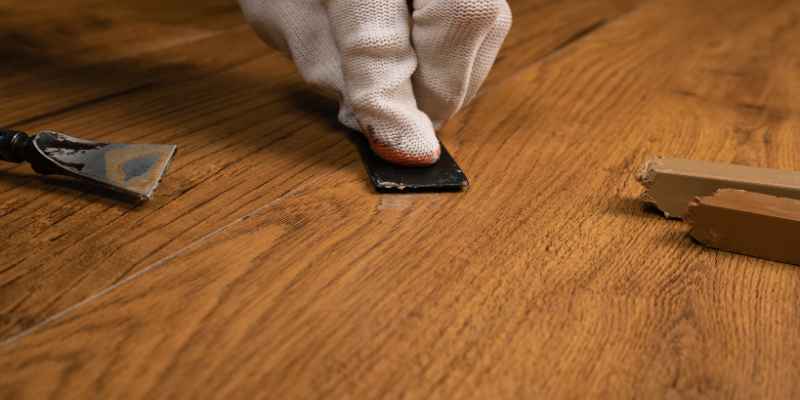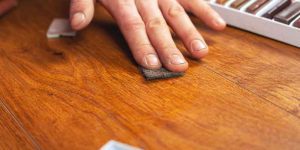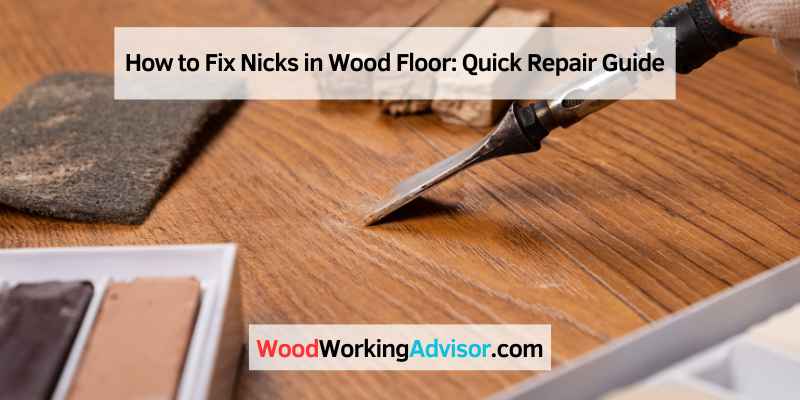To fix nicks in a wood floor, start by cleaning the area and applying wood filler to the nick. Sand the filler until smooth and then apply a matching stain and finish.
This will seamlessly blend the repair with the rest of the floor, restoring its appearance. A wood floor adds warmth and character to any space, but nicks and scratches can detract from its beauty. Fortunately, repairing these imperfections is a straightforward process that can be done with a few simple tools and materials.
Whether your wood floor has sustained minor nicks or deeper scratches, there are effective solutions to restore its flawless finish. In this guide, we’ll explore practical methods to fix nicks in wood floors, allowing you to maintain the natural charm and elegance of your hardwood flooring.
Introduction To Wood Floor Repair
Learn how to fix nicks in wood floors with these easy steps. First, clean the affected area with a damp rag. Then, apply wood filler and sand it until it’s smooth. Finish by staining and applying a polyurethane sealer.
Quick Fixes Vs. Long-term Solutions
When it comes to fixing nicks in wood floors, you have two options: quick fixes or long-term solutions. Quick fixes are temporary solutions that provide a temporary improvement in the appearance of the floor. On the other hand, long-term solutions aim to fix the underlying issue and restore the floor to its original condition. Let’s explore both options in more detail.
Identifying Types Of Damage
Before you can begin the repair process, it’s important to identify the types of damage your wood floor has sustained. This will help you determine the most appropriate method for fixing the nicks. Here are some common types of damage you may encounter:
- Surface Scratches: These are shallow marks on the surface of the wood that typically do not penetrate the finish.
- Gouges: Gouges are deeper cuts or indentations in the wood that can be more challenging to fix.
- Chips: Chips occur when a small piece of wood has been completely broken off from the floor.
- Cracks: Cracks are narrow openings in the wood that can occur due to changes in humidity or aging.
Now that we have a better understanding of the types of damage we may encounter, let’s dive into the different methods for fixing nicks in wood floors.
Preparing The Damaged Area
To fix nicks in a wood floor, preparing the damaged area is crucial. Start by cleaning the area with a damp rag and removing any debris. Then, apply wood filler to the nick and sand it down until it’s smooth.
Finish by applying stain and a polyurethane sealer to match the rest of the floor.
Cleaning The Nick
Begin by cleaning the nicked area with a damp cloth to remove any dirt, dust, or debris. This will ensure a clean surface for the repair process.
Assessing The Depth Of Damage
Next, assess the depth of the damage to determine the extent of the repair needed. Use your fingers to feel the depth of the nick, or gently run a small tool, such as a credit card, over the damaged area to assess its depth.
Tools And Materials Needed
Fixing nicks in your wood floor is a great way to keep it looking beautiful and new. Here are the tools and materials needed to fix the nicks:
Selecting The Right Wood Filler
When it comes to selecting the right wood filler, there are a few important things to keep in mind:
- The color of the wood filler should match the color of your floor.
- The wood filler should be able to withstand the wear and tear of foot traffic.
- The wood filler should be easy to sand and finish.
Matching The Wood Finish
Matching the wood finish is just as important as selecting the right wood filler. To ensure a perfect match, follow these steps:
- Take a sample of your floor to your local hardware store to find a matching wood finish.
- Apply the wood finish to a small, inconspicuous area of your floor to test the color.
- Once you have the right color, apply the wood finish to the patched area using a clean brush.
- Allow the wood finish to dry completely before walking on the floor.
By following these steps and using the right tools and materials, you can fix nicks in your wood floor and keep it looking beautiful for years to come.
Filling Nicks And Small Gouges
To fix nicks in a wood floor, start by cleaning the area around the nick with a damp rag. Then, apply wood filler to the nick, remove any excess filler, and sand the area smooth. Finally, apply a matching stain and a protective polyurethane finish to blend the repair seamlessly into the floor.
Filling Nicks and Small Gouges in your wood floor can be easily done with the right tools and techniques. One of the most common methods is using wood filler, which can be applied to the damaged area to fill in the nick or gouge. Here’s how to do it:
Applying Wood Filler
1. Choose a wood filler that matches the color of your floor.
2. Clean the damaged area with a damp cloth and let it dry completely.
3. Apply the wood filler to the damaged area with a putty knife, making sure to fill it completely.
4. Smooth out the wood filler with the putty knife and remove any excess.
5. Allow the filler to dry completely.
Drying Time And Curing
After applying the wood filler, it’s important to allow it to dry completely. The drying time will depend on the type of filler you’re using, but it typically takes around 24 hours. Once the filler is dry, you can sand the area to make it smooth and even. It’s important to note that the filler will shrink as it dries, so you may need to apply a second coat to ensure it’s completely filled.
In conclusion, filling nicks and small gouges in your wood floor is an easy DIY project that can save you money and extend the life of your floor. By following these simple steps, you can repair your damaged floor and make it look like new again.
Sanding For A Smooth Finish

When it comes to fixing nicks in a wood floor, sanding is an essential step to achieve a smooth and flawless finish. Sanding helps to level out the surface and remove any imperfections, allowing for a seamless repair. In this section, we will discuss the importance of choosing the correct sandpaper and different sanding techniques to ensure a professional result.
Choosing The Correct Sandpaper
Choosing the correct sandpaper is crucial to achieve the desired smooth finish on your wood floor. Different sandpaper grits are suitable for different purposes. Here is a quick guide to help you choose the right sandpaper for your project:
| Grit | Recommended Use |
|---|---|
| Coarse (60-80) | Used to remove deep scratches and level uneven surfaces. |
| Medium (100-150) | Ideal for general sanding and smoothing out rough areas. |
| Fine (180-220) | Used for final sanding to achieve a smooth and polished finish. |
By selecting the appropriate grit for your specific needs, you can ensure an effective and efficient sanding process.
Sanding Techniques
Once you have chosen the correct sandpaper, it’s important to employ the right sanding techniques to achieve the best results. Here are some key techniques to keep in mind:
- Start with the coarsest sandpaper grit to remove any deep scratches or uneven areas.
- Always sand in the direction of the wood grain to avoid damaging the surface.
- Apply even pressure while sanding, ensuring consistent results across the entire area.
- Gradually work your way up to finer grits to achieve a smooth and polished finish.
- Regularly clean the sandpaper or replace it if it becomes clogged with wood particles.
- After sanding, make sure to thoroughly clean the area to remove any dust or debris.
By following these sanding techniques, you can effectively fix nicks in your wood floor and achieve a flawless and professional finish.
Staining To Match Existing Floor
When fixing nicks in a wood floor, staining to match the existing floor is crucial for a seamless repair.
Testing Stain Colors
Before applying the stain, test different colors on a discreet area of the floor to ensure a perfect match.
Application Tips
- Clean the damaged area thoroughly before applying the stain.
- Apply the stain with a cloth or brush in the direction of the grain.
- Allow the stain to dry completely before applying a protective finish.
Sealing And Protecting The Repair
To seal and protect the repair of nicks in a wood floor, follow these steps: sand the area until smooth, apply a wood filler or putty to fill the nicks, let it dry, sand again if necessary, and finally, apply a sealant or finish to protect the repaired area.
This will ensure a seamless and long-lasting fix for your wood floor.
Types Of Sealers
When it comes to sealing and protecting a wood floor repair, there are various types of sealers available. Some common options include:
- Water-based sealers
- Oil-based sealers
- Polyurethane sealers
Applying Polyurethane
If you choose to use polyurethane sealer for your wood floor repair, follow these steps:
- Clean the repaired area thoroughly.
- Apply polyurethane in thin, even coats.
- Allow each coat to dry completely before applying the next.
- Sand lightly between coats for a smooth finish.
Polyurethane sealers offer durability and protection to the repaired area, ensuring a long-lasting fix for nicks in your wood floor.
Alternative Quick Fixes
When it comes to fixing nicks in a wood floor, there are alternative quick fixes that can help address minor scratches and imperfections. These quick fixes are easy to implement and can make a noticeable difference in the appearance of your wood floor.
Using Nuts For Minor Scratches
If you have minor scratches on your wood floor, one quick fix is to use nuts to help fill in the scratches. Simply rub a shelled nut over the scratched area to help disguise the imperfections. The natural oils in the nut can help darken the wood, making the scratches less noticeable.
DIY Mixtures For Lighter Scratches
For lighter scratches on your wood floor, DIY mixtures can be an effective solution. One option is to create a paste using equal parts of olive oil and baking soda. Apply the paste to the scratches and gently rub it into the wood to help diminish the appearance of the scratches.
Preventing Future Damage
Learn how to fix nicks in wood floors and prevent future damage with these simple steps. Sand the area to remove surface scratches, apply wood filler for deeper nicks, and finish with a protective sealant. Keep your wood floors looking flawless for years to come.
Regular Floor Maintenance
To maintain your wood floors, sweep and mop regularly.
Consider using furniture pads to prevent scratches.
Inspect for nicks and scratches routinely.
Protective Measures
Place doormats at entryways to trap dirt and debris.
Use rugs in high-traffic areas to protect the wood.
Avoid dragging heavy furniture across the floor.
Remember, prevention is key to preserving your wood floors for years to come.
When To Call A Professional
To fix nicks in a wood floor, it’s best to call a professional if the damage is extensive or if you’re uncertain about the repair process. However, minor nicks can be easily fixed using wood fillers and touch-up kits, following the manufacturer’s instructions carefully.
If you have nicks in your wood floor, you may be wondering whether you should attempt to fix them yourself or call a professional. While minor nicks can often be repaired with some DIY methods, there are certain situations where it’s best to leave the job to the experts. In this section, we will explore the signs of major damage and provide tips on finding a trusted flooring specialist.
Signs Of Major Damage
Before attempting to fix nicks in your wood floor, it’s important to assess the severity of the damage. Here are some signs that indicate you may be dealing with major damage:
- Deep gouges or large scratches that go beyond the surface layer
- Cracks or splits in the wood
- Warping or buckling of the floorboards
- Significant water damage or mold growth
If you notice any of these signs, it’s recommended to call a professional for assistance. Attempting to repair major damage on your own can lead to further issues and potentially cause more harm than good.
Finding A Trusted Flooring Specialist
When it comes to fixing nicks in your wood floor, it’s essential to find a trusted and experienced flooring specialist. Here are some tips to help you in your search:
- Ask for recommendations from friends, family, or neighbors who have had their wood floors repaired or refinished.
- Check online directories and review websites to find local flooring specialists with positive reviews and ratings.
- Verify the credentials and certifications of the flooring specialist to ensure they have the necessary expertise.
- Request quotes from multiple professionals to compare prices and services offered.
- Ask for references and examples of their previous work to gauge their level of craftsmanship and attention to detail.
By following these steps, you can find a reliable professional who will help you restore your wood floor to its former glory.

Frequently Asked Questions
How Do You Fix A Nick In A Hardwood Floor?
To fix a nick in a hardwood floor, use a wood filler that matches the floor color. Apply the filler to the nick, then sand it smooth and apply a matching stain. Finish by applying polyurethane to seal the repair.
How To Fix A Chipped Hardwood Floor?
To fix a chipped hardwood floor, follow these steps: 1. Clean the area with a damp rag. 2. Apply wood filler to the chip. 3. Sand the filled area. 4. Apply matching hard wax. 5. Buff the repaired spot to blend.
How Do You Get Scratches Out Of Hardwood Floors Without Sanding?
To remove scratches from hardwood floors without sanding, use natural remedies like olive oil, baking soda, or raw walnuts. Create a paste with equal parts of olive oil and baking soda, and apply it to the scratches. Alternatively, rub raw walnuts onto the scratches for a DIY fix.
How Do You Remove Nicks From Wood?
To remove nicks from wood, sand the surface until smooth, then apply wood filler for gouges. For light scratches, use an abrasive pad or fine sandpaper. Clean the area with a soft cloth and hardwood cleaner. Natural remedies like olive oil, baking soda, or raw walnuts can also help.
Conclusion
Fixing nicks in wood floors is a manageable task with the right tools and techniques. By addressing the issue promptly, you can prevent further damage and maintain the beauty of your wood flooring. With the simple steps outlined in this guide, you can restore your wood floors to their original elegance.

